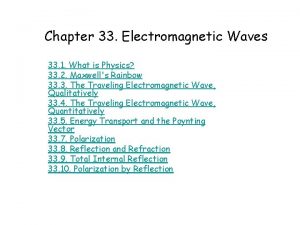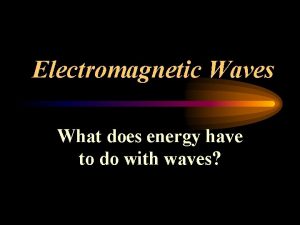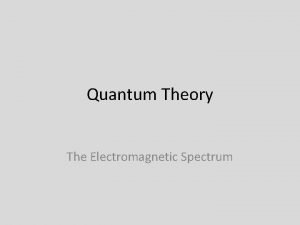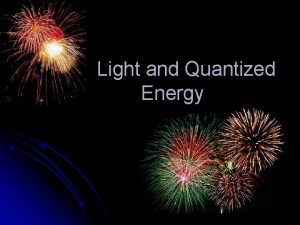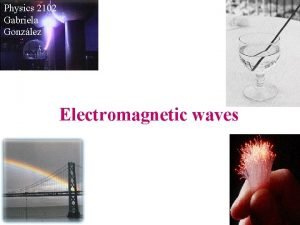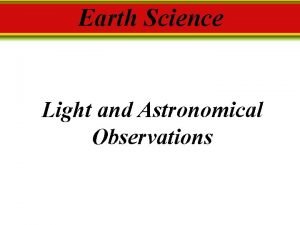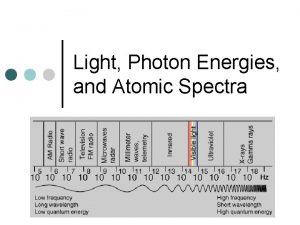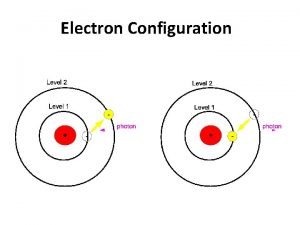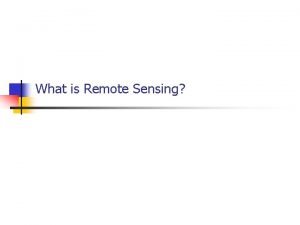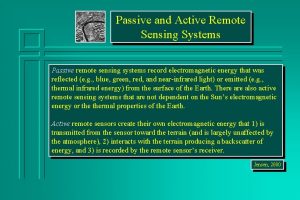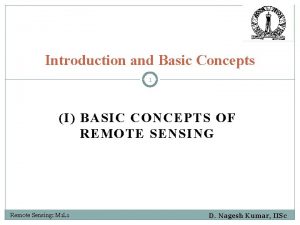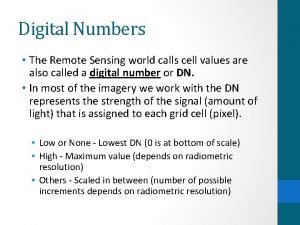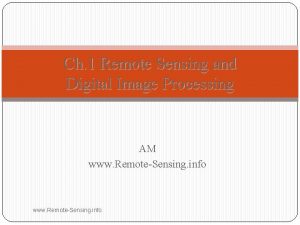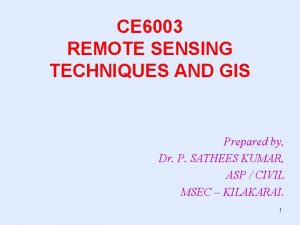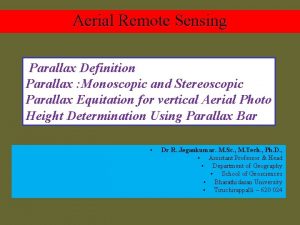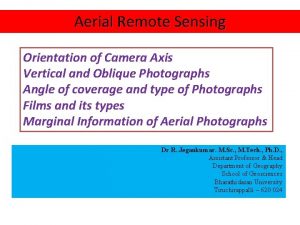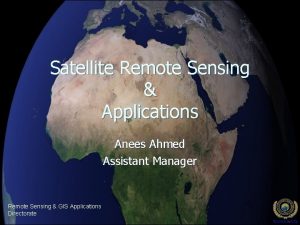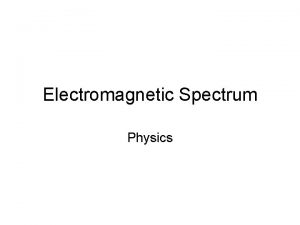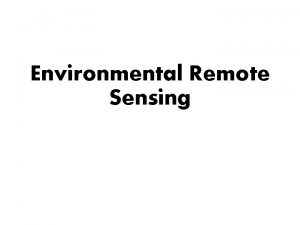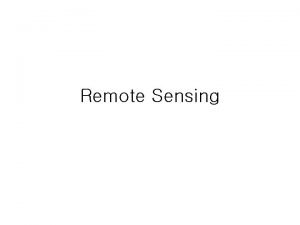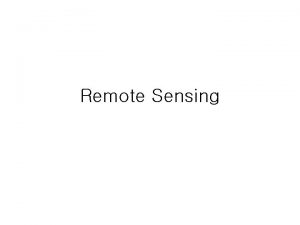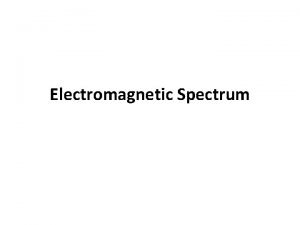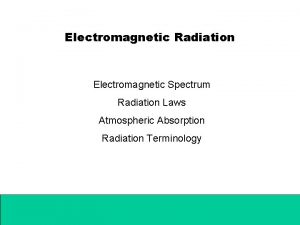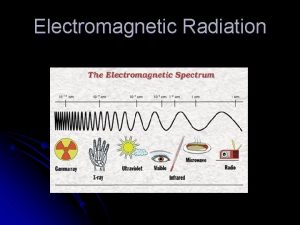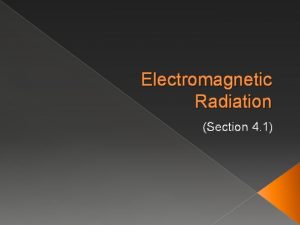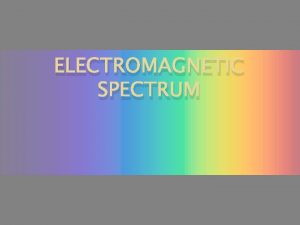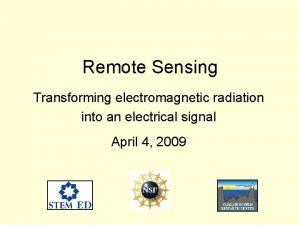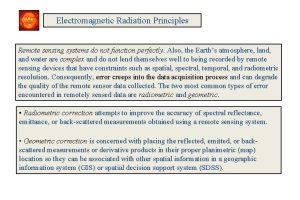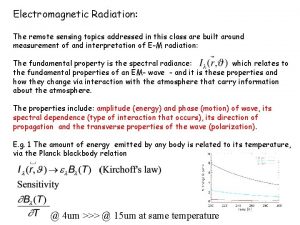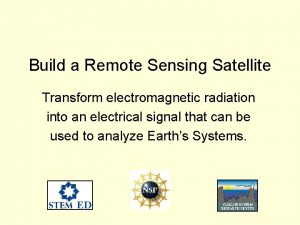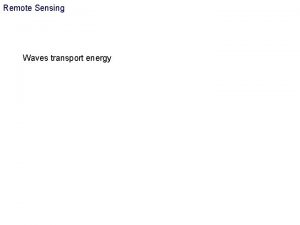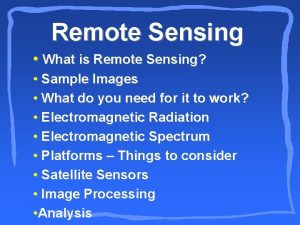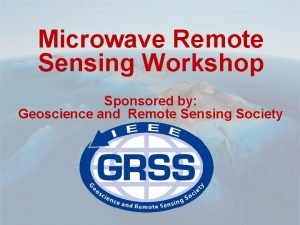Remote Sensing Electromagnetic Radiation Remote Sensing Definition I






















- Slides: 22

Remote Sensing Electromagnetic Radiation

Remote Sensing Definition "I want to know how God created this world. I am not interested in this or that phenomenon, in the spectrum of this or that element. I want to know His thoughts; -the rest are details. “ Albert Einstein

Remote Sensing Definition ► Science and art of obtaining information about an object, area, or phenomenon through the analysis of data acquired by a device that is not in contact with object, area, or phenomenon.

Remote Sensing Processes ► Data acquisition - energy sources - energy through the atmosphere - interaction with surface features - retransmission - sensor systems - data - interpretation and analysis

Remote Sensing Processes. .

Remote Sensing Processes. . Data analysis: - data processing - compilation - application ► “DIKI” data information knowledge intelligence ►

Electronic Radiation ► The sun produces a full spectrum of electromagnetic radiation http: //csep 10. phys. utk. edu/astr 162/lect/light/spectrum. html http: //kr. blog. yahoo. com/bmw 26 z/2188

Two Components of EM Radiation ► Electrical field (E): varies in magnitude in a direction perpendicular to the direction of propagation ► Magnetic field (M): at right angle to the electrical field, is propagated in phase with the electrical field

Components of EM Radiation v

Three Properties of EM Energy Wavelength ( ) ► Frequency ( ) ► Amplitude ►

Wavelength ( ) The distance from one wave crest to the next ► Measurement units: micrometer (mm) 1 m = 1, 000 mm, 1 mm = 1, 000 microm ►

Frequency ( ) The number of crests passing a fixed point in a given period of time ► Measure units: hertz (cycle per second) ►

Amplitude The height of each peak ► Measured as watts per square meter (energy level) ►

Three Properties ► Among the three properties, wavelength is the most commonly used in the field of remote sensing

Three Properties. .

Speed of EM ► The speed of EM energy c 300, 000 km/second, c = and are inversely related

Electromagnetic Spectrum ► Spectrum of electromagnetic radiation ► Major divisions of EM spectrum http: //csep 10. phys. utk. edu/astr 162/lect/light/spectrum. html http: //imagers. gsfc. nasa. gov/ems. html

Major Divisions of EM Spectrum Ultraviolet spectrum: 0. 3 - 0. 38 microm ► Visible spectrum: - blue 0. 4 - 0. 5 microm - green 0. 5 - 0. 6 microm - red 0. 6 - 0. 72 microm ► 1 m = 1, 000 mm = 1, 000 micrometer ►

Major Divisions of EM Spectrum ► ► Infrared spectrum: - near infrared: 0. 72 - 1. 3 microm - mid infrared: 1. 30 - 3. 0 microm - far infrared: 7. 00 - 15 microm, emitted from the earth Microwave spectrum: 1 mm - 1 m

The Dual Nature of Light (Newton) Light is formed by a stream of quanta (photons) that travels in straight line. The size of each quantum is directly proportional to the frequency of the energy's radiation Q = h ► The quantum model best explains the photoelectric effect ►

The Dual Nature of Light ► ► EM energy propagates as a series of waves The wave model best explains the refraction and diffraction

Readings ► Chapter 1
 Gis definition ap human geography
Gis definition ap human geography Intensity of electromagnetic wave
Intensity of electromagnetic wave Facts about electromagnetic radiation
Facts about electromagnetic radiation Wavelength formulas
Wavelength formulas Types of radiation in the electromagnetic spectrum
Types of radiation in the electromagnetic spectrum Intensity of electromagnetic radiation
Intensity of electromagnetic radiation Which telescope detects invisible electromagnetic radiation
Which telescope detects invisible electromagnetic radiation Transverse wave vs longitudinal wave
Transverse wave vs longitudinal wave Electromagnetic.spectrum
Electromagnetic.spectrum When electromagnetic radiation of wavelength 300
When electromagnetic radiation of wavelength 300 Sub orbitals
Sub orbitals Energy transfer
Energy transfer Remote sensing platforms
Remote sensing platforms Active vs passive remote sensing
Active vs passive remote sensing Limitations of remote sensing
Limitations of remote sensing Digital number remote sensing
Digital number remote sensing Limitations of remote sensing
Limitations of remote sensing Idealized remote sensing system
Idealized remote sensing system Proportional symbol map ap human geography
Proportional symbol map ap human geography Remote sensing
Remote sensing What is stereoscopic parallax
What is stereoscopic parallax Strip camera in remote sensing
Strip camera in remote sensing Remote sensing image
Remote sensing image

